Short T.A. Electric Power Distribution Handbook
Подождите немного. Документ загружается.


598
Electric Power Distribution Handbook
where
S
f
is the shielding factor, which is between 0 and 1. In Florida, shield-
ing factors of around 0.7 were found for circuits out of four substations
(Parrish and Kvaltine, 1989). Lines in these areas had moderate to heavy
shielding by nearby objects.
12.3 Traveling Waves
When lightning injects surge currents into power lines, they move down the
conductors as traveling waves. Understanding the nature of traveling waves
helps in predicting the voltage and current levels that occur on power sys-
tems during lightning strikes. Surges travel at 99% the speed of light on
overhead circuits — about 1000 ft/
m
sec(300 m/
m
sec). The inductance
L
and
capacitance
C
uniformly distributed along the line determine the velocity
and the relationship between voltage and current. The velocity in a unit
length per second is based on
L
and
C
per length unit as
The voltage and current are related by
Z
, the
surge impedance
,
V = ZI
where
Z
is a real value, typically 300 to 400
W
. The distributed inductance
and capacitance determines the surge impedance:
where
h
, average conductor height
r
, conductor radius
When surge voltages of like polarity pass over each other, the voltages
add as shown in Figure 12.7. The currents subtract; current is charge moving
in a direction. Charge of the same polarity flowing in opposite directions
cancels.
NN S
S
f
=-()1
v
LC
=
1
Z
L
C
h
r
==60 60
2
ln
VV V ZI I
IZI I
FB FB
FB
=+= -
=+
()
()
1791_book.fm Page 598 Monday, August 4, 2003 3:20 PM
(C) 2004 by CRC Press LLC
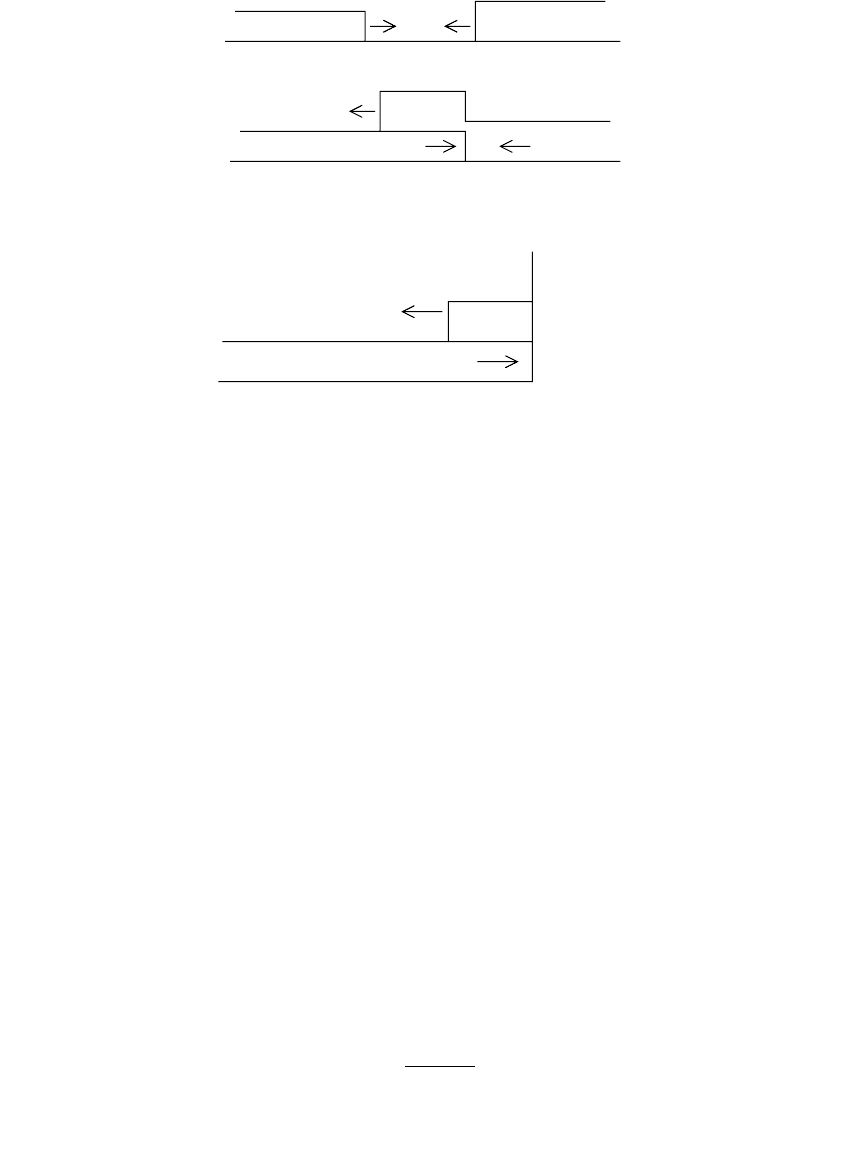
Lightning Protection 599
A surge arriving at an open point in the circuit reflects, sending back a
voltage wave equal to the incoming wave (see Figure 12.8). The voltage
doubles. Think of the incoming wave as a stream of electrons. When these
electrons hit the open point, they stop, but the pileup of electrons at the end
forces the electrons back in the direction they came from (like charges repel
each other). While the voltage doubles, the current cancels to zero as the
return wave counters the incoming wave.
Voltage doubling at open points is an important consideration for the
protection of distribution insulation. It is a very important consideration
when protecting underground cables. It also comes into play when placing
arresters to protect a substation.
When a surge hits a short circuit, the voltage drops to zero as we expect.
The ground releases opposing charge that cancels the voltage, creating a
reverse wave traveling back toward the source. Now the current doubles. Two
cases are very close to a short circuit: a conducting surge arrester and a fault
arc. Both of these act like a short. They generate a voltage canceling wave.
Line taps, capacitors, open points, underground taps — any impedance
discontinuities — cause reflections. In the general case, the voltage wave
reflected from a discontinuity is
where a is the reflection coefficient:
FIGURE 12.7
Forward and backward traveling waves passing each other.
FIGURE 12.8
Traveling wave reflection at an open point.
+
+
++
+
+
++
+
+
+
+
+
+
+
+++
+
+
+
+
+
+
+
+
+
+
Open point
VaV
RI
=
a
ZZ
ZZ
BA
BA
=
-
+
1791_book.fm Page 599 Monday, August 4, 2003 3:20 PM
(C) 2004 by CRC Press LLC
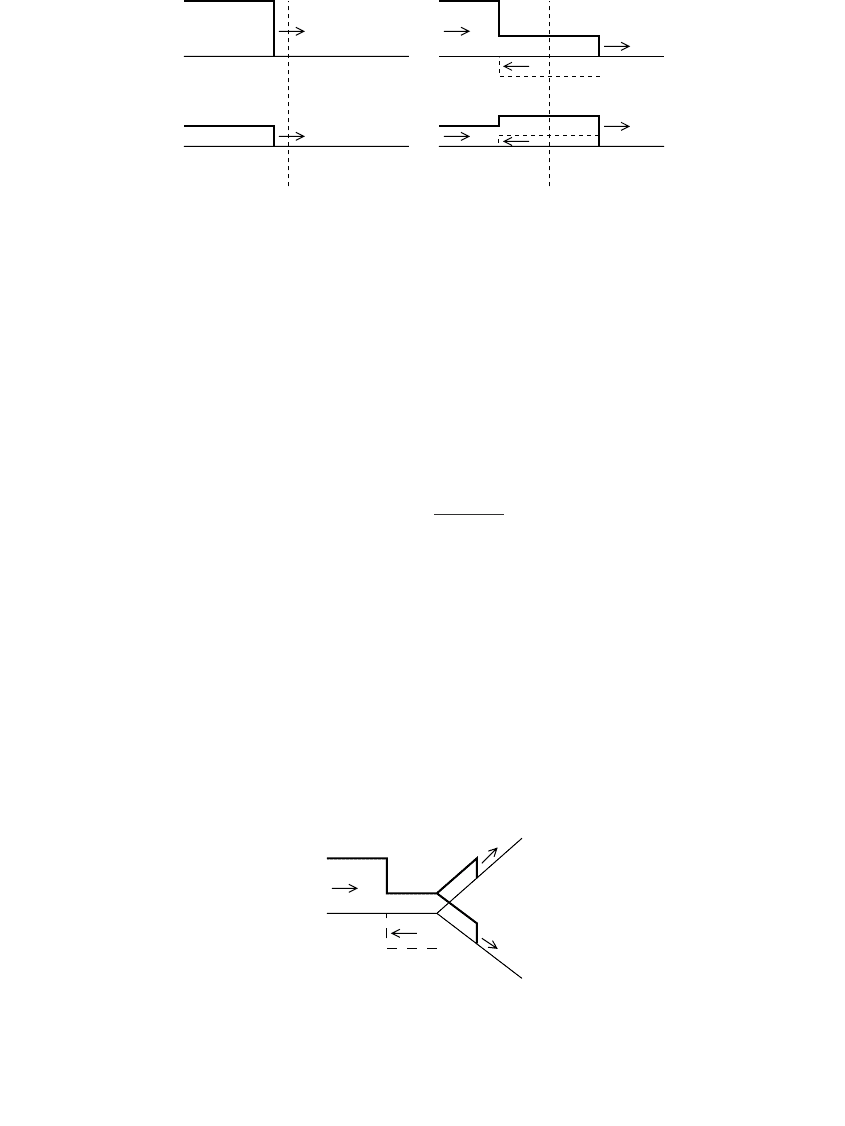
600 Electric Power Distribution Handbook
For an open circuit (Z
B
= •), the reflection coefficient, a = 1, and for a short
circuit (Z
B
= 0), a = –1.
The voltage at the discontinuity is the sum of the incoming wave and the
reflected wave:
where b is the refraction coefficient:
The current waves are found from the voltages as for forward
waves and for backward waves. See Figure 12.9.
When a traveling wave hits a split in the line, a portion of the wave goes
down each path and another wave reflects back toward the source as shown
in Figures 12.10. Use to calculate the voltage at the split, just use
a new Z
B
’ as the parallel combination of Z
B
and Z
C
,
. For equal surge impedances (Z
A
= Z
B
= Z
C
), the total voltage
is 2/3 of the incoming wave.
To a traveling wave, a capacitor initially appears as a very small imped-
ance, almost a short circuit. Then, as the capacitor charges, the effective
FIGURE 12.9
Traveling wave reflection at a surge-impedance discontinuity where Z
B
< Z
A
.
FIGURE 12.10
Traveling wave reflections at a split.
Before After
Z
B
V
I
Z
A
Z
B
I
I
Z
A
Z
B
V
I
Z
A
Z
B
I
I
Z
A
I
R
I
T
V
T
V
R
VVVVaV bV
TIRI I I
=+ =+ =
ba
Z
ZZ
B
BA
=+=
+
1
2
IVZ
FF
= /
IVZ
BB
=- /
VbV
TI
=
¢
=
=
ZZ Z
BB C
||
+ZZ Z Z
BC B C
/( )
Z
B
V
I
Z
A
V
T
V
R
Z
C
1791_book.fm Page 600 Monday, August 4, 2003 3:20 PM
(C) 2004 by CRC Press LLC

Lightning Protection 601
impedance rises until it becomes an open circuit with the capacitor fully
charged. For a traveling wave section terminated in a capacitor, the voltage
ramps up to double the voltage as
An inductance initially appears almost as an open circuit. As the inductor
allows more current to flow, its impedance drops until it is equivalent to a
short circuit. For a traveling wave section terminated in an inductor, the
voltage initially doubles then decays down to zero as
A cable section attached to an overhead circuit behaves similarly to a
capacitor. It is like an open-circuited traveling wave section with a low surge
impedance. In fact, a capacitor can be modeled in a traveling wave program
such as EMTP as a traveling wave section with a surge impedance of Dt/2
C and a travel time of Dt/2, where Dt is small (usually the time step of the
simulation) (Dommel, 1986). Likewise, we may model an inductor as a
traveling wave section shorted at the end with a surge impedance equal to
2L/Dt and a travel time of Dt/2.
Corona impacts traveling waves by modifying the surge impedance. When
lightning strikes an overhead distribution circuit, tremendous voltages are
created. The voltage stress on the conductor surface breaks down the air
surrounding the conductor, releasing charge into the air in many small
streamers. A high-voltage transmission line may have a corona envelope of
several feet (1 m), which increases the capacitance. This decreases the surge
impedance and increases coupling to other conductors and slopes off the
front of the wave. Normally, distribution line insulation flashes over before
significant corona develops, so we can neglect corona in most cases.
Predischarge currents, an effect similar to corona, may also form between
conductors. When the voltage between two parallel conductors reaches the
flashover strength of air (about 180 kV/ft or 600 kV/m), a sheet of many
small streamers containing predischarge currents flows between the conduc-
tors. This is a precursor to a complete breakdown. The predischarge current
delays the breakdown and relieves voltage stress between the conductors.
While the predischarge currents are flowing, the resistance across the gap is
400 W/ft or 1310 W/m of line section (Wagner, 1964; Wagner and Hileman,
1963; Wagner and Hileman, 1964). Normally, on overhead distribution cir-
cuits, the weakest insulation is at poles, so in most cases, the circuit flashes
over before the circuit enters the predischarge state. Predischarge currents
do make midspan flashovers less likely and may help with using arresters
to protect lines.
VV e
TI
t
ZC
=-
Ê
Ë
Á
ˆ
¯
˜
-
21
VV e
TI
Z
L
t
=-
Ê
Ë
Á
ˆ
¯
˜
-
21
1791_book.fm Page 601 Monday, August 4, 2003 3:20 PM
(C) 2004 by CRC Press LLC

602 Electric Power Distribution Handbook
Normally, for modeling lightning in circuits or cables, we can ignore corona
and predischarge and use lossless line sections (wire resistance and damping
is ignored). This is normally sufficient since only short sections need to be
modeled for most situations.
A multiconductor circuit has several modes of propagation; each has dif-
ferent velocity and different surge impedance. In most cases, these multi-
conductor effects are ignored, and we assume each wave travels on each
conductor at 95 to 100% of the speed of light.
For multiconductor circuits, the coupling between circuits is important.
The mutual surge impedance determines the voltage on one conductor for
a current flowing in another as V
2
= Z
12
I
1
. The mutual surge impedance is
where
a
ij
, distance between conductor i and the image conductor j
b
ij
, distance between conductor i and conductor j
Conductors that are closer together couple more tightly. This generally
helps by reducing the voltage stress between the conductors.
12.4 Surge Arresters
Modern surge arresters have metal-oxide blocks, highly nonlinear resistors.
Under normal voltages, a metal-oxide surge arrester is almost an open cir-
cuit, drawing much less than a milliampere (and the watts losses are on the
order of 0.05 W/kV of MCOV rating). Responding to an overvoltage almost
instantly, the impedance on the metal-oxide blocks drops to a few ohms or
less for severe surges. After the surge is done, the metal oxide immediately
returns to its normal high impedance. Metal-oxide blocks are primarily zinc
oxide with other materials added. Boundaries separate conductive zinc-
oxide grains. These boundaries form semiconductor junctions like a semi-
conducting diode. A metal-oxide block is equivalent to millions of series and
parallel combinations of semiconducting diodes. With low voltage across
the boundaries, the resistance is very high, but with high voltage, the resis-
tance of the boundaries becomes very low.
Metal-oxide surge arresters overcame many drawbacks of earlier designs.
The spark gap was one of the earliest devices used to protect insulation
against lightning damage. A spark gap has many of the desirable benefits
of a surge arrester; the gap is an open circuit under normal conditions and
when it sparks over, the gap is virtually a short circuit. The problem is that
after the surge, the gap is still shorted out, so a fuse or circuit breaker must
Z
a
b
ij
ij
ij
= 60 ln
1791_book.fm Page 602 Monday, August 4, 2003 3:20 PM
(C) 2004 by CRC Press LLC
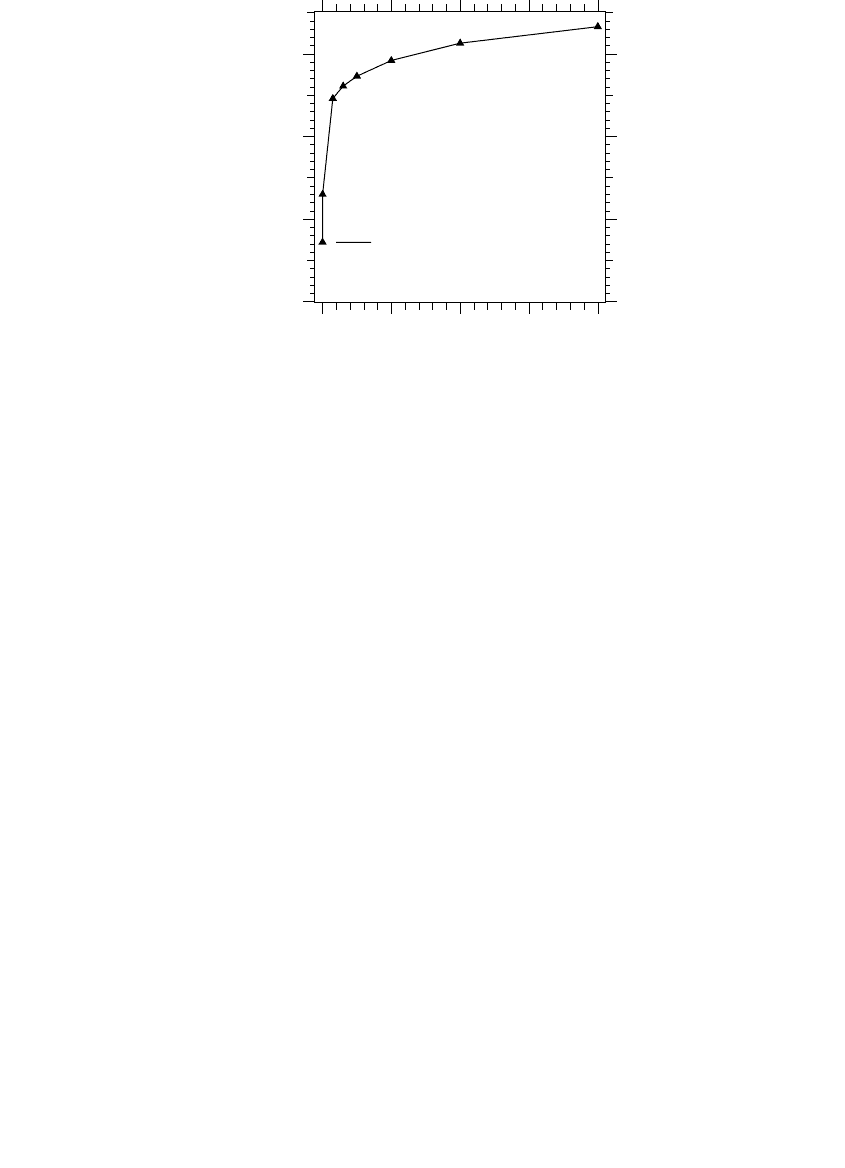
Lightning Protection 603
operate. In some parts of the world, notably Europe, spark gaps are still
widely used to protect transformers. Spark gaps were improved by adding
nonlinear resistors in series. The nonlinear material would clear the power
follow current flowing through the spark gap after the surge was done.
Gapped arresters with silicon carbide blocks were developed in the 1940s
and used for many years. Metal oxide is so nonlinear that a gap is not
required. This allows an arrester design, which is simple and highly reliable,
with excellent “fast-front” response characteristics. Figure 12.11 shows the
voltage-current relationships of a typical metal-oxide arrester. At distribution
voltages, metal oxide was first used to provide better protection at riser poles
feeding underground cables (Burke and Sakshaug, 1981).
Distribution surge arresters are primarily for protection against lightning
(not switching surges or other overvoltages). In areas without lightning they
would not be needed. That said, most utilities in low-lightning areas use
arresters even if the cost of arresters exceeds the cost of occasional failures.
If a utility is hit with a 1-in-40-year storm, it can wipe out a significant
portion of unprotected transformers, enough that the utility does not have
the inventory to replace them all, and some customers would have very
long interruptions.
Arresters must be placed as close as possible to the equipment being
protected. This means on the same pole because lightning has such high
rates of rise, an arrester one pole span away provides little protection. At
the pole structure, the best place for the arrester is right on the equipment
tank to minimize the inductance of the arrester leads.
Arresters protect any equipment susceptible to permanent damage from
lightning. Figure 12.12 shows examples of arrester applications. Transform-
FIGURE 12.11
Typical characteristics of an 8.4-kV MCOV arrester (typically used on a system with a nominal
voltage of 7.2 or 7.62 kV from line to ground).
Nominal voltage
0 10 20 30 40
0
10
20
30
Current, kA
Voltage, kV
1791_book.fm Page 603 Monday, August 4, 2003 3:20 PM
(C) 2004 by CRC Press LLC
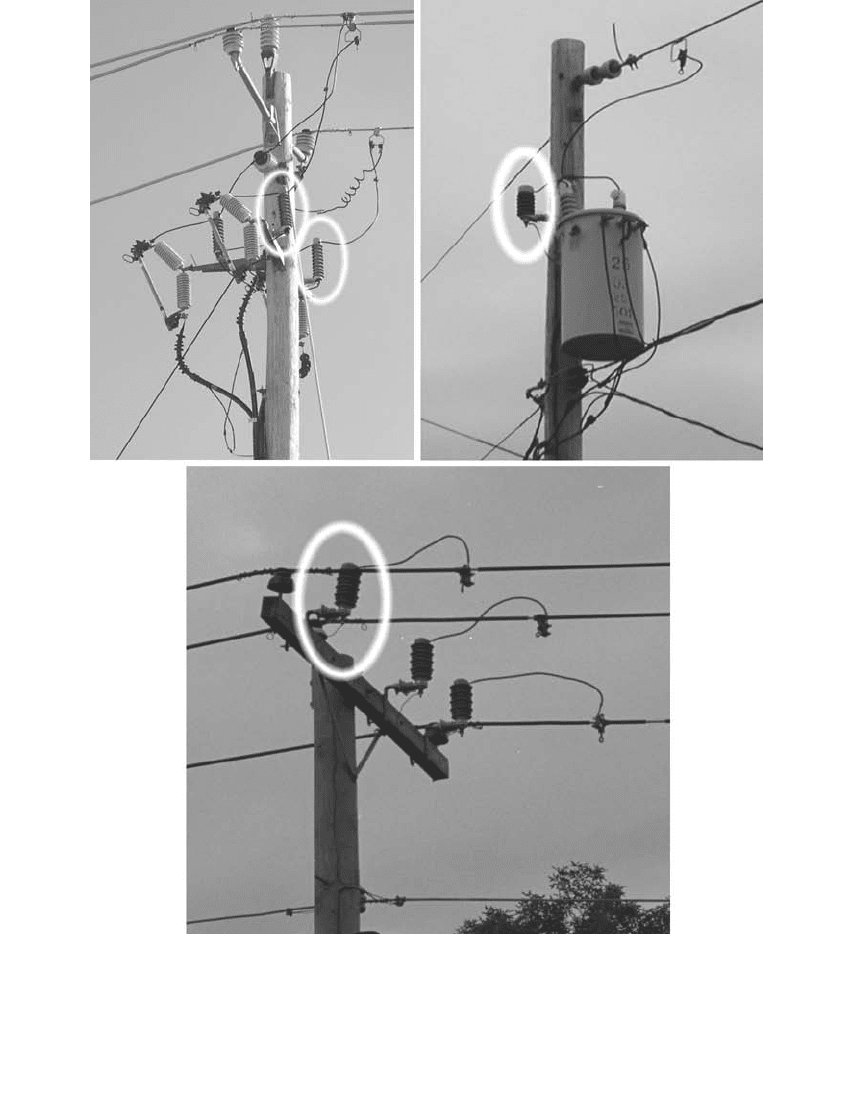
604 Electric Power Distribution Handbook
FIGURE 12.12
Example arrester applications.
1791_book.fm Page 604 Monday, August 4, 2003 3:20 PM
(C) 2004 by CRC Press LLC

Lightning Protection 605
ers should have arresters. Two-terminal devices such as reclosers, regulators,
and vacuum switches should have arresters on both the incoming and out-
going sides. Arresters on reclosers are especially important. When the
recloser is open, a surge hitting the open point will double. Commonly,
reclosers open to clear lightning-caused faults, and if the downstream side
is not protected, a subsequent lightning stroke that followed the one that
caused the fault could fail the open recloser. Cables need special attention
to prevent lightning entry and damage. At equipment with predominantly
air flashover paths — insulators, switches, cutouts — utilities do not nor-
mally use arresters.
Most utilities also protect capacitor banks with arresters. Some believe
that capacitors protect themselves because capacitors have low impedance
to a fast-changing surge. While this is somewhat true, nearby direct light-
ning flashes may still fail capacitors. About 1.9 C, which is a small first
stroke, charges a 400-kvar, 7.2-kV capacitor unit to 95 kV (the BIL for 15-
kV equipment).
Several classes of arresters are available for protecting distribution
equipment:
• Riser pole — Designed for use at a riser pole (the junction between
an overhead line and a cable); has better protective characteristics
than heavy-duty arresters (because of voltage doubling, under-
ground protection is more difficult)
• Heavy duty — Used in areas with average or above average lightning
activity
• Normal duty — Higher protective levels and less energy capability.
Used in areas with average or below average lightning activity
• Light duty — Light-duty arrester used for protection of underground
equipment where most of the lightning current is discharged by
another arrester at the junction between an overhead line and the cable
Two protective levels quantify an arrester’s performance (IEEE Std. C62.22-
1997):
• Front-of-wave protective level (FOW) — The crest voltage from a cur-
rent wave causing the voltage to rise to crest in 0.5 msec.
• Lightning impulse protective level (LPL) — The crest voltage for an 8/
20-msec current injection (8 msec is the equivalent time to crest based
on the time from 10 to 90% of the crest, and 20 msec is the time
between the origin of the 10 to 90% virtual front and the half-value
point). These characteristics are produced for current peaks of 1.5,
3, 5, 10, and 20 kA.
Table 12.4 gives common ranges. Lower protective levels protect equip-
ment better.
1791_book.fm Page 605 Monday, August 4, 2003 3:20 PM
(C) 2004 by CRC Press LLC

606 Electric Power Distribution Handbook
12.4.1 Ratings and Selection
The choice of arrester rating depends on the voltage under normal conditions
and possible temporary overvoltages. Temporary overvoltages during line-
to-ground faults on the unfaulted phases are the main concern, therefore,
system grounding plays a large role in arrester application.
The most important rating of a metal-oxide arrester is the maximum con-
tinuous operating voltage (MCOV). Arresters also have another voltage rat-
ing called the duty-cycle rating (this rating is very commonly used to refer
to a particular arrester). The duty cycle rating is about 20% higher than the
MCOV rating. Within a given rating class, arresters may have different
performance characteristics (such as the discharge voltage and the energy-
handling capability). For example, one 8.4-kV MCOV normal-duty arrester
may have a protective level for a 10-kA, 8/20-msec current injection of 36
kV. A riser-pole arrester of the same rating may have a 27-kV protective level.
Operating voltage is the first criteria for applying arresters. The arrester
MCOV rating must be above the normal upper limit on steady-state voltage.
Some engineers use the upper (ANSI C84.1-1995) range B, which is slightly
less than 6% above nominal. Use 10% above the nominal line-to-ground
voltage to be more conservative.
Temporary overvoltages are the second application criteria. An arrester
must withstand the temporary overvoltages that occur during line-to-
ground faults on the unfaulted phases. The overvoltages are due to a neutral
shift. On an ungrounded system, a ground fault shifts the neutral point to
the faulted phase. The arresters connected to the unfaulted phases see line-
to-line voltage. Four-wire multigrounded systems are grounded but still see
TABLE 12.4
Common Ranges of Protective Levels
Duty
Cycle
Rating
kV rms
MCOV
kV rms
Front-of-Wave Protective
Level, kV
Maximum Discharge Voltage,
kV 8/20 mm
mm
sec Current Wave
5 kA
Normal
Duty
10 kA
Heavy
Duty
10 kA
Riser
Pole
5 kA
Normal
Duty
10 kA
Heavy
Duty
10 kA
Riser
Pole
3 2.55 11.2–17 13.5–17 10.4 10.2–16 9.1–16 8.2
6 5.1 22.3–25.5 26.5–35.3 17.4–18 20.3–24 18.2–25 16.2
9 7.65 33.5–36 26.5–35.3 22.5–36 30–33.5 21.7–31.5 20–24.9
10 8.4 36–37.2 29.4–39.2 26–36 31.5–33.8 24.5–35 22.5–26.6
12 10.2 44.7–50 35.3–50 34.8–37.5 40.6–44 32.1–44 30–32.4
15 12.7 54–58.5 42–59 39–54 50.7–52 35.9–52 33–40.2
18 15.3 63–67 51–68 47–63 58–60.9 43.3–61 40–48
21 17.0 73–80 57–81 52–63.1 64–75 47.8–75 44–56.1
24 19.5 89–92 68–93 63–72.5 81.1–83 57.6–83 53–64.7
27 22.0 94–100.5 77–102 71–81.9 87–91.1 65.1–91 60–72.1
30 24.4 107–180 85–109.5 78–85.1 94.5–99 71.8–99 66–79.5
36 29.0 125 99–136 91–102.8 116 83.7–125 77–96
Source: IEEE Std. C62.22-1997. Copyright 1998 IEEE. All rights reserved.
1791_book.fm Page 606 Monday, August 4, 2003 3:20 PM
(C) 2004 by CRC Press LLC
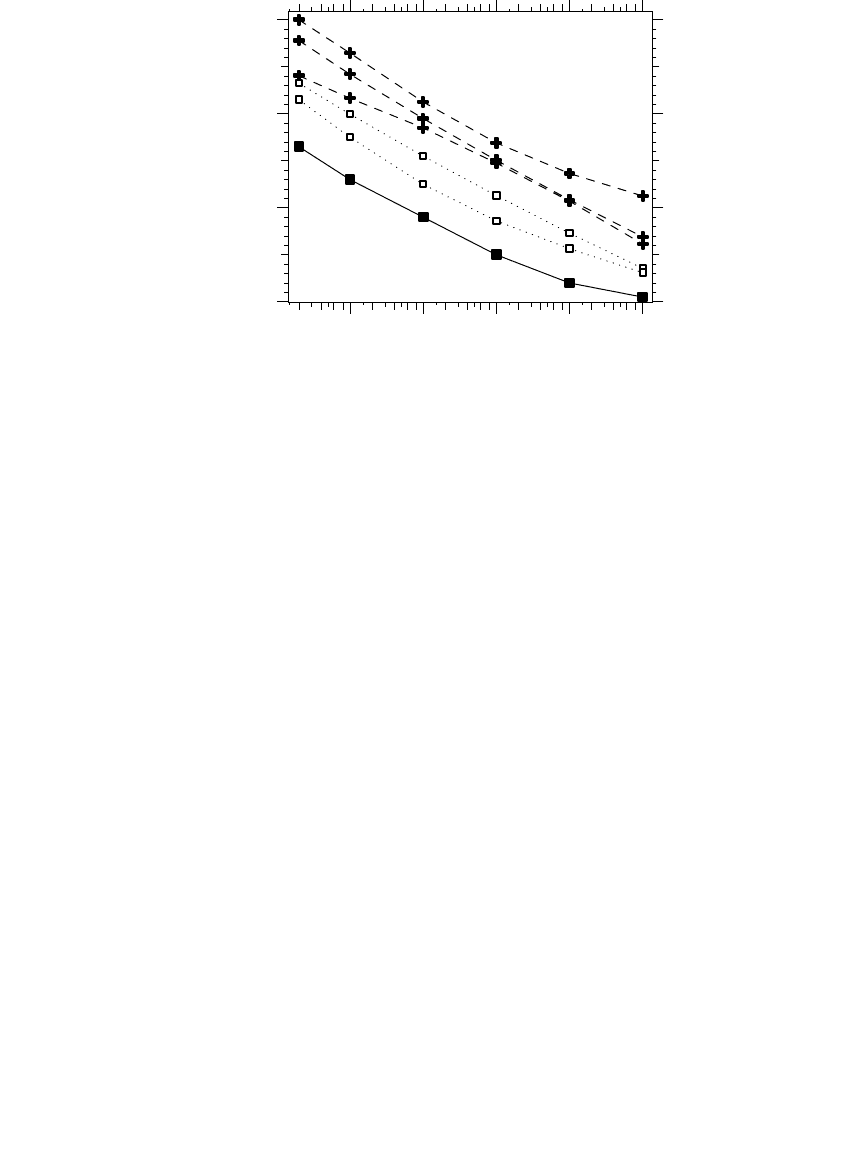
Lightning Protection 607
some neutral shift. (IEEE C62.92.4-1991) recommends using a 1.35 per unit
overvoltage factor for a multigrounded system. Chapter 13 has more infor-
mation on overvoltages during ground faults.
Arrester temporary overvoltage (TOV) capabilities are time-dependent;
manufacturers publish temporary overvoltage curves for their arresters (see
Figure 12.13). The duration of the overvoltage depends on the relaying and
fusing. Normally, this varies, and since arrester applications are not individ-
ually engineered, a value is normally assumed.
On four-wire multigrounded systems, the MCOV criteria, not the TOV
criteria, determines the arrester application. On ungrounded or impedance-
grounded circuits, TOV capability determines the rating.
Riser-pole arresters have less temporary overvoltage capability than normal
or heavy-duty arresters. Riser-pole arresters normally have the same arrester
block size as heavy-duty arresters; the manufacturer chooses blocks carefully
to find those with lower discharge voltages. A lower discharge characteristic
means more current and energy for a given temporary overvoltage.
Utilities typically standardize arrester ratings for a given voltage and
grounding configuration. Table 12.5 shows some common applications. For
the four-wire systems, most are okay, but try to avoid the tight applications
such as the 9-kV duty cycle arrester at 12.47 kV and the 10-kV duty cycle
arrester at 13.8 kV.
For ungrounded circuits, the voltage on the unfaulted phases rises to the
line-to-line voltage. This normally requires an arrester with an MCOV equal
to the line-to-line voltage because the fault current is so low on an
ungrounded system that single line-to-ground faults are difficult to detect.
FIGURE 12.13
Temporary-overvoltage capabilities of several different arrester manufacturers and models
(dashed-lines: heavy-duty arresters, dotted lines: riser-pole arresters, bottom line: lowest TOV
capability expected as published in IEEE Std. C62.22-1997).
0.1 1.0 10.0 100.0 1000.
1.2
1.4
1.6
1.8
Time, seconds
Temporary overvoltage capability
[per unit of MCOV]
1791_book.fm Page 607 Monday, August 4, 2003 3:20 PM
(C) 2004 by CRC Press LLC
